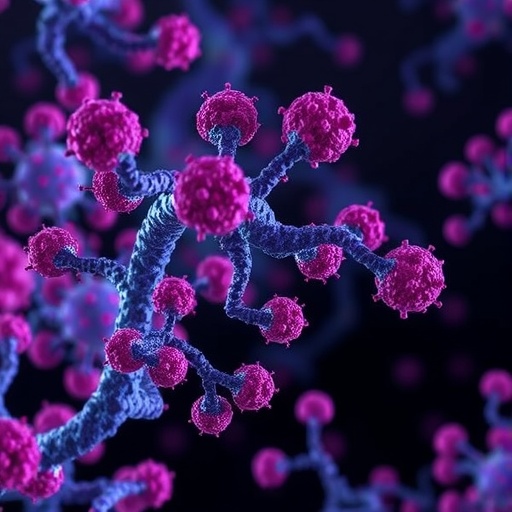In a groundbreaking study published in BMC Cancer, researchers have unveiled a novel multi-omics approach that dissects the complex landscape of bidirectional liquid–liquid phase separation (LLPS) in renal cell carcinoma (RCC), with profound implications for immunotherapy response and patient prognosis. The investigation leverages cutting-edge genomic technologies to decode the role of LLPS-related genes, marking a significant advance in the precision oncology of kidney cancer.
Renal cell carcinoma, particularly its clear cell subtype, remains notoriously difficult to treat, with variable responses to immune checkpoint inhibitors posing a critical challenge for clinicians. This study addresses an urgent need to identify molecular signatures that reliably predict therapeutic outcomes. By focusing on the dynamic process of LLPS, a fundamental cellular phenomenon where biomolecules undergo reversible condensation, the researchers illuminate how this biophysical mechanism influences tumor biology and immune interactions.
Central to the study is the development of a Bidirectional Liquid-Liquid Phase Separation-associated Index (B-LLPSI), intricately crafted from the expression profiles of three key genes: GPRIN1, TTK, and DTL. These genes were meticulously selected through rigorous Mendelian randomization screening, ensuring their causal link to RCC pathogenesis and progression. The B-LLPSI emerges as a potent predictive tool, capable of stratifying patients according to likely immunotherapy benefits, a leap toward tailored treatment paradigms.
The methodological sophistication of the research is anchored in integrative multi-omics analyses, encompassing genomics, transcriptomics, and proteomics data derived from extensive RCC cohorts. This comprehensive approach enabled the discovery of bidirectional patterns in LLPS-associated gene expression, revealing dual roles of these molecules in promoting or suppressing tumor progression depending on their cellular context. Such insights underscore the complexity of LLPS phenomena within cancer cells and their microenvironment.
Further deepening their findings, the team identified small-molecule inhibitors targeting TTK, a kinase implicated in cell cycle regulation and LLPS dynamics. These therapeutic candidates hold promise not only for direct antitumor activity but also for modulating LLPS processes to enhance immunogenicity. The discovery paves a new path toward drug development that exploits the biophysical underpinnings of tumor cell survival and immune evasion.
Validation of the prognostic significance of GPRIN1, TTK, and DTL was expanded beyond RCC, encompassing a broad spectrum of malignancies in a pan-cancer analysis. This integrative effort confirmed consistent expression patterns correlating with patient outcomes, reinforcing the universal relevance of LLPS-related mechanisms across cancer types. Such pan-cancer validation bolsters the clinical utility of these biomarkers in oncology.
At the functional level, experimental silencing of the three signature genes demonstrated compelling inhibition of renal clear cell carcinoma cell proliferation and invasiveness. This knockdown approach substantiates their active role in tumor progression, positioning them as promising therapeutic targets. By bridging molecular genetics with cellular assays, the study offers robust mechanistic evidence linking LLPS gene dysregulation to RCC aggressiveness.
Immunotherapy, a transformative modality in oncology, suffers from inconsistent efficacy in RCC due to incomplete understanding of tumor immune landscapes. The B-LLPSI provides a refined biomarker framework that integrates LLPS biology with immune responsiveness, potentially guiding patient selection for immunotherapies such as PD-1/PD-L1 inhibitors. This alignment embodies a stride toward personalized medicine, optimizing treatment based on tumor-intrinsic properties.
The researchers also dissected the interplay between LLPS gene signatures and tumor microenvironment components, revealing correlations with immune cell infiltration, cytokine profiles, and checkpoint molecule expression. These findings suggest that LLPS processes modulate not only tumor cell behavior but also immune surveillance and evasion, highlighting a multifaceted influence on cancer immunity.
Importantly, the study situates the role of LLPS within the broader context of cell biology, where phase separation regulates diverse cellular functions including chromatin organization, RNA metabolism, and signal transduction. Aberrations in LLPS, as exemplified by dysregulated GPRIN1, TTK, and DTL expression, disrupt homeostasis and foster oncogenic transformation. This insight offers a conceptual framework linking physical cell states with molecular oncogenesis.
From a translational perspective, the identification of small molecules targeting LLPS-related kinases spurs innovative therapeutic strategies. These agents could synergize with existing immunotherapies, augmenting their efficacy by remodeling the physical and molecular landscape of cancer cells. Clinical trials informed by the B-LLPSI stratification may validate such combination therapies, heralding improved outcomes for RCC patients.
Moreover, the application of Mendelian randomization strengthens the causal inference in linking LLPS genes to renal carcinoma progression, mitigating confounding factors commonly encountered in observational studies. This level of genetic rigor enhances the confidence in proposed biomarkers and therapeutic targets, setting a new standard in cancer biomarker research.
The study’s approach also exemplifies the power of systems biology, integrating high-dimensional data to construct predictive indices reflective of complex biological processes. By modeling bidirectional LLPS signatures, the research captures dynamic tumor heterogeneity, moving beyond static biomarkers to embrace cellular plasticity and adaptability.
Future directions inspired by this work include exploring the temporal dynamics of LLPS in tumor evolution, assessing how phase separation impacts resistance mechanisms to immunotherapies, and expanding these findings to other cancer types. The interplay between LLPS and epigenetic regulation also warrants investigation, potentially uncovering further layers of tumor control.
In sum, this pioneering multi-omics analysis of bidirectional LLPS signatures sets a new frontier in understanding RCC biology and immunotherapy response. By bridging molecular mechanisms, cellular biophysics, and clinical outcomes, it charts an innovative course toward precision oncology that could transform patient care and inspire broad scientific inquiry.
Subject of Research: Multi-omics analysis of bidirectional liquid–liquid phase separation signatures in renal cell carcinoma and their implications for immunotherapy response and prognosis.
Article Title: Multi-omics analysis of bidirectional liquid–liquid phase separation signatures reveals immunotherapy response and prognosis in renal cell carcinoma.
Article References:
Wang, Z., Li, H., Hou, X. et al. Multi-omics analysis of bidirectional liquid–liquid phase separation signatures reveals immunotherapy response and prognosis in renal cell carcinoma. BMC Cancer 25, 1314 (2025). https://doi.org/10.1186/s12885-025-14749-x
Image Credits: Scienmag.com




